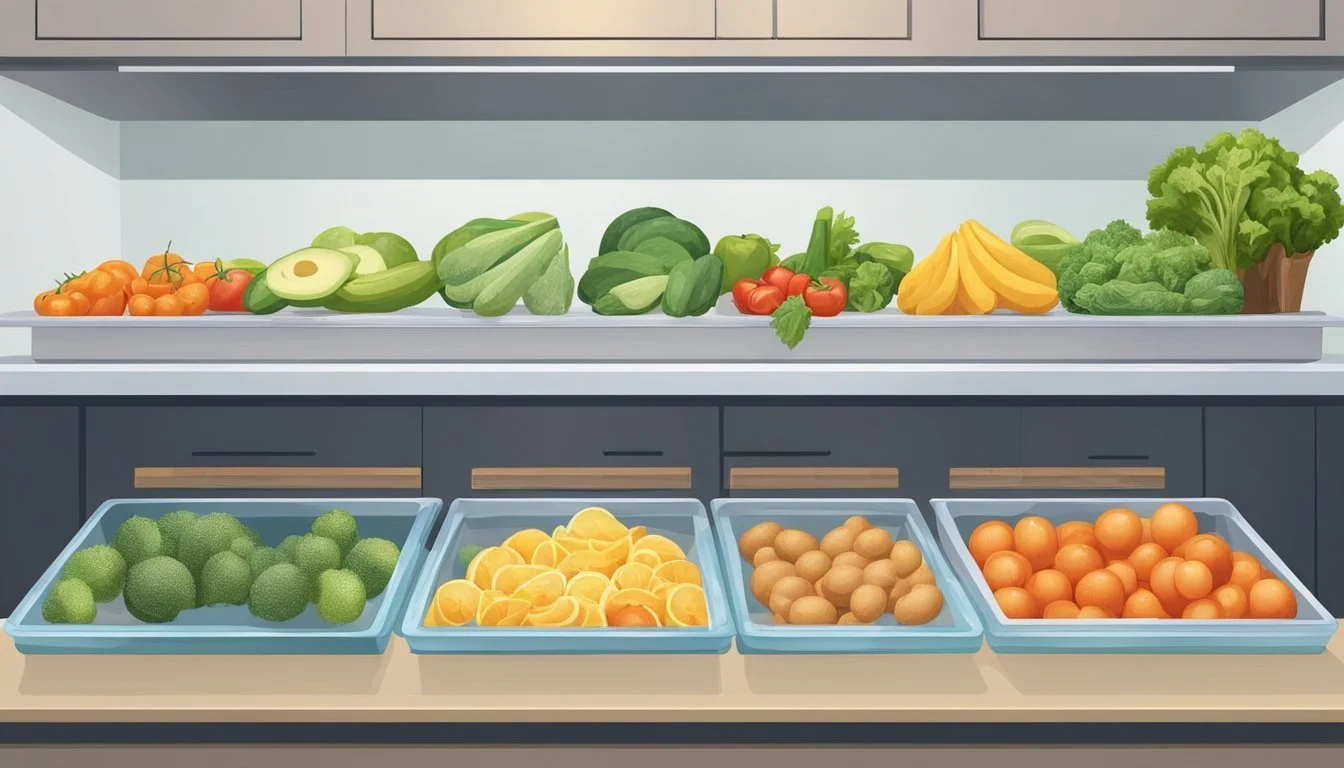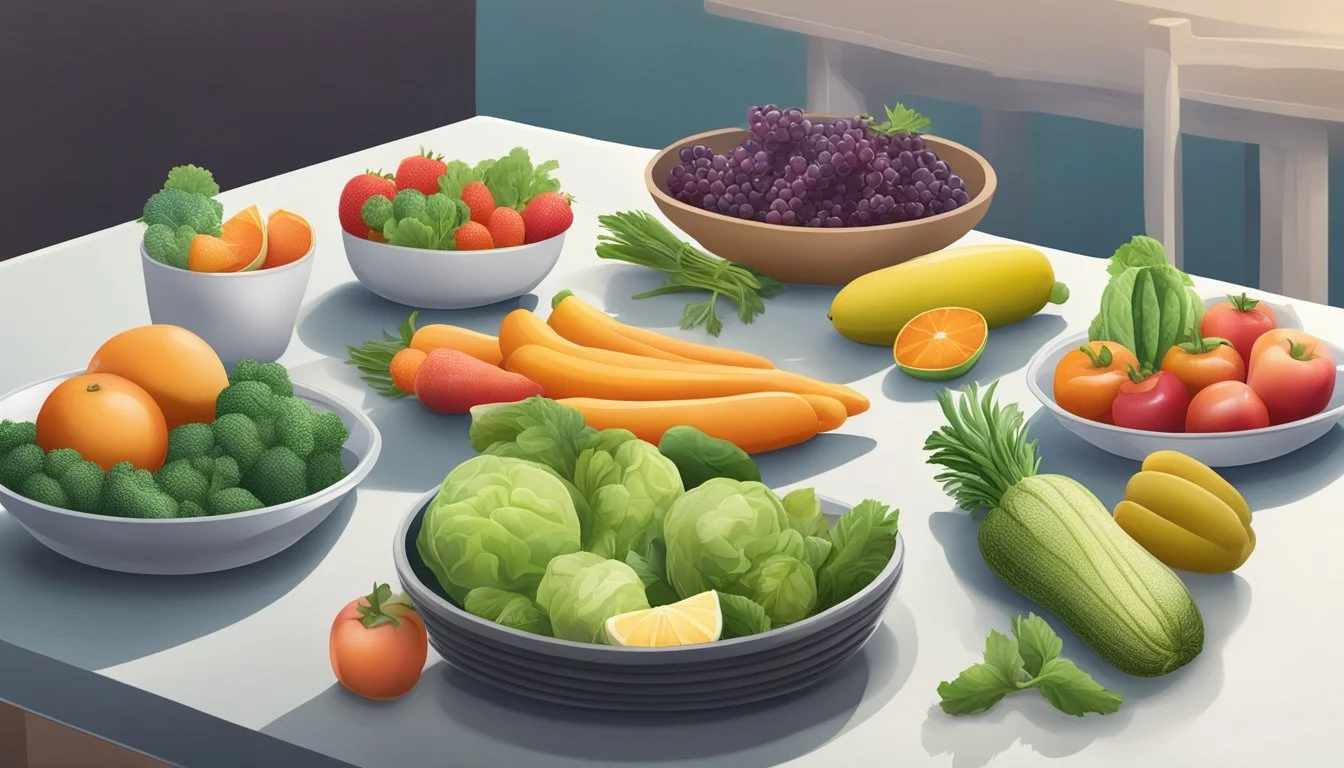Keto Diet: Fresh vs Frozen Foods
Maximizing Nutritional Value
The ketogenic diet, commonly referred to as the keto diet, emphasizes high-fat, moderate-protein, and very low-carb foods to propel the body into a state of ketosis, where it burns fat for fuel instead of carbohydrates. This diet has become increasingly popular for its potential benefits in weight loss, blood sugar control, and improved cognitive function. Central to maintaining this dietary regimen is a keen understanding of which foods to include and which to avoid to remain within the carb limit.
When adopting a keto diet, many wonder whether fresh or frozen foods are preferable. Fresh vegetables, for instance, are often celebrated for their crisp texture and possibly higher nutrient content, but convenience and shelf life are important factors that frozen options provide. Vegetables, regardless of being fresh, frozen, or even canned should be chosen based on their carbohydrate content since the goal is to minimize carb intake. Foods like leafy greens, above ground vegetables, meats, and high-fat dairy are staples in the keto diet, but understanding their nutritional differences when fresh or frozen can aid individuals in making informed decisions that align with their health goals and lifestyle needs.
It's worth noting that frozen foods can be nutritionally comparable to fresh ones and, in some cases, may even retain vitamins better due to flash freezing after harvest. Consequently, both fresh and frozen foods have a place in the keto diet, and the choice between them can be based on convenience, budget, and personal preference without compromising the dietary principles of keto. The key is to select low-carb options, such as non-starchy vegetables and minimally processed meats, ensuring one's food choices support the rigorous demands of a ketogenic lifestyle.
Understanding Keto Diet Fundamentals
The ketogenic diet is a high-fat, adequate-protein, and low-carbohydrate eating plan designed to trigger a metabolic state called ketosis, where the body utilizes fat as its primary source of energy.
Principles of Ketosis
Ketosis occurs when carbohydrate intake is significantly reduced to around 20-50 grams per day, leading the body to convert fat into ketones for energy. This physiological state is the cornerstone of the ketogenic diet.
Benefits and Risks
Adopting a ketogenic diet may result in weight loss, lower blood pressure, and improved blood sugar control, potentially reducing heart disease risk. However, the diet may also present risks such as nutrient deficiencies and increased cholesterol levels, calling for careful monitoring.
Macro-Nutrient Ratios
Typical macronutrient distribution for a ketogenic diet is as follows:
Fat: 70-80%
Protein: 20-25%
Carbohydrates: 5-10% Calculating net carbs (total carbs minus fiber) is crucial for staying within ketogenic guidelines.
Keto-Adaptation Process
During the fat adaptation phase, the body transitions to efficiently burn fat for fuel. This adaptation can take several weeks, during which individuals might experience temporary side effects often referred to as the "keto flu."
Food Categories to Embrace
Foods to include in a ketogenic diet are:
Meat: High in protein and fat, ideal for keto.
Fish and Seafood: Rich in omega-3 fatty acids.
Eggs: Versatile and low in carbs.
Non-starchy Vegetables: High in fiber and nutrients with minimal carbs.
Healthy Oils: For example, coconut, olive, and avocado oils.
Nuts and Seeds: Good sources of fat and fiber.
Low-Carb Fruits: Primarily berries, which have lower net carb content.
Dairy Products: High-fat options such as cheese and butter.
Foods to Avoid on Keto
Avoid high-carb foods to maintain ketosis, including:
Sugary Foods: Desserts, ice cream, sweetened yogurts.
Grains: Bread, pasta, rice, and breakfast cereals.
Starchy Vegetables: Potatoes and high-carb fruits like bananas.
Legumes: Beans and lentils.
Managing Macronutrients
Monitor macronutrient intake to maintain proper ketone levels. Adjust ratios of fat, protein, and carbs to individual metabolic needs and goals.
Keto for Different Lifestyles
The ketogenic diet can be adapted for various lifestyles including vegetarian, pescatarian, or dairy-free. Key adjustments involve sourcing protein and fat from non-meat options without increasing carb intake.
Addressing Common Misconceptions
One common misconception is that eating more fat is harmful. On keto, dietary fat becomes the main energy source and can be beneficial when sourced from healthy fats. It's a common myth that keto completely eliminates carbohydrates, whereas the focus is on net carbs for energy without spiking blood sugar.
Supplements and Keto
Supplements can be used to fill nutritional gaps on the ketogenic diet, ensuring adequate intake of fiber, minerals, vitamins, and antioxidants. Common supplements include magnesium, omega-3 fatty acids, and vitamin D.
The Role of Fresh Foods in Keto Diet
Fresh foods play a critical role in the ketogenic diet. Providing essential nutrients while keeping net carbs low, fresh produce, meats, dairy, and select fruits enable individuals to adhere to the keto lifestyle effectively.
Nutritional Value of Fresh Produce
Fresh vegetables are pivotal in the ketogenic diet for their high fiber, vitamins, minerals, and antioxidants, with low net carbs. Non-starchy vegetables such as leafy greens, cucumbers, and bell peppers offer essential nutrients while keeping carbohydrate intake minimal. Consuming a variety of these vegetables ensures a wide range of health benefits due to their high water content and nutrient density.
Benefits of Fresh Meat and Seafood
Meat, fish, and seafood are cornerstones of the keto diet, offering high-quality protein and essential B vitamins, potassium, and selenium. Fresh options like salmon, chicken, and beef provide the body with necessary nutrients without adding excess carbs, supporting muscle maintenance and overall health.
Incorporating Dairy and Eggs
Dairy products such as cheese, butter, cream, and Greek yogurt are excellent keto-friendly foods that supply ample calcium and healthy fats. Fresh eggs are a staple in the ketogenic diet, rich in protein and fats with minimal carbs. These dairy and egg products can be included regularly in meals to ensure a balanced macro profile.
Selection of Low-Carb Fruits and Vegetables
The keto diet does accommodate certain fruits, especially those with lower net carbs known as berries. Blackberries, strawberries, raspberries, and blueberries contain fewer carbs yet are rich in antioxidants and fiber. Avocados, a source of healthy fats and nearly 20 vitamins and minerals, are highly valued in keto for their versatility and nutrient profile.
Understanding Frozen Foods on Keto
When following a ketogenic diet, incorporating frozen foods can offer both convenience and nutrition. Frozen options can be a practical solution for maintaining a low-carb, high-fat diet when fresh foods are not readily available.
Quality and Convenience of Frozen Options
Frozen foods are invaluable for keto meal prep, providing a longer shelf life and reducing food waste. They can be especially useful for those with limited time to acquire and prepare fresh produce, meat, and fish. While the process of freezing can sometimes affect taste and texture, the quality of frozen foods has improved significantly with advancements in quick-freezing technology. Store-bought frozen options also offer year-round availability of seasonal specialties.
Impact of Freezing on Nutrition
The nutrient profile of foods can change with freezing, but the impact is generally minimal for keto-friendly foods like vegetables, meat, and fish. Freezing can actually preserve the vitamins, minerals, and antioxidants present in foods at the time of freezing. For the most part, frozen vegetables and berries retain their nutritional value quite well compared to their fresh counterparts, which can lose nutrients over time due to prolonged transport and storage.
Best Frozen Foods for Keto
A ketogenic diet emphasizes low net carb intake and high fat, making certain frozen foods more suitable than others. Here are some optimal frozen choices for those on keto:
Vegetables: Look for leafy greens, cauliflower, broccoli, and spinach, which are low in net carbs and high in fiber.
Meat and Seafood: Choose unprocessed cuts of beef, pork, poultry, fish, and shellfish with no added carbohydrates or preservatives.
Berries: Opt for strawberries, raspberries, and blackberries, which are on the lower end in net carbs and sugars.
Reading Labels on Frozen Foods
When selecting frozen items, it’s crucial to read the nutrition labels carefully. Look for:
Net Carbs: Total carbohydrates minus fiber references the amount impacting ketosis. Stay within your daily carb limit.
Sodium: While necessary in moderation, some frozen foods can be high in sodium, impacting blood pressure and fluid retention.
Calories and Fat: Keep track of the calorie and fat content, ensuring it aligns with your daily goals.
Preservatives and Sugars: Be wary of added preservatives, sugars, or other ingredients that might disrupt your state of ketosis.
Incorporating frozen foods into a ketogenic diet can be both convenient and beneficial, but as with any food choices on this diet, mindfulness and label reading are key.
Meal Planning and Preparation
Successful keto dieting hinges on careful meal planning and preparation to maintain blood sugar levels, control carbs, and ensure adequate intake of protein and fiber. This section delves into creating keto-friendly meal ideas, effective meal prep strategies, and navigating the fresh versus frozen foods debate, all while considering flavor, convenience, cost, nutritional value, and food safety.
Keto-Friendly Meal Ideas
Keto meal plans revolve around high-fat, moderate-protein, and low-carb foods. Focus on including a variety of meats, fish, and seafood for protein. Incorporate non-starchy vegetables and dark leafy greens for essential vitamins and minerals. Nuts, seeds, and dark chocolate offer nutrient-dense snacking options. Each meal should provide a balanced portion of these ingredients to promote weight loss and manage blood sugar levels.
Breakfast: Scrambled eggs with spinach and avocado.
Lunch: Grilled chicken salad with a mix of nuts and seeds.
Dinner: Baked salmon with asparagus and a side of sautéed kale.
Meal Prep Strategies for Success
Meal prep is invaluable for maintaining a keto diet. Plan meals that can be made in bulk and refrigerate or freeze portions for later. Use portion control to ensure each meal aligns with daily macronutrient goals. Preparing meals in advance helps avoid the convenience of carb-heavy options, reinforces food safety, and aids in managing portion sizes.
Plan Ahead: Outline a week’s menu including snacks.
Prep in Batches: Cook large quantities of staple items like meat or eggs.
Portion Control: Divide meals into containers for easy access and to prevent overeating.
Fresh vs Frozen: Making the Right Choice
Both fresh and frozen foods have a place in the keto diet. Fresh foods may offer better flavor and texture, especially for salads and raw dishes. However, frozen options provide convenience, may cost less, and can retain nutritional value since they are frozen at peak ripeness. When selecting frozen foods, choose those without added sauces or sugars that could increase carb content.
Fresh Foods: Ideal for salads, stir-fries, and meals where texture is key.
Frozen Foods: Best for smoothies, soups, or as a backup when fresh isn't available.
Batch Cooking and Storage Tips
Batch cooking is essential for keto meal prep. Cook large quantities of keto staples like meat or egg-based dishes that can be easily reheated. Store these meals using food safety guidelines to maximize shelf life. Refrigerate what you'll eat within a few days and freeze the rest in appropriate portions. Label containers with content and date to track consumption and minimize waste.
Cooking: Use a slow cooker or oven to prepare meals in large quantities.
Storage: Invest in quality containers that are freezer-safe and BPA-free.
Organization: Keep the refrigerator and freezer organized to track inventory and expiration dates.
Potential Health Implications
In considering the health implications of the ketogenic diet, one must weigh the effects on blood sugar and insulin levels, impact on cholesterol and blood pressure, and possible long-term health outcomes.
Effects on Blood Sugar and Insulin
The ketogenic diet drastically reduces carbohydrate intake, which can lead to a state of ketosis. During ketosis, blood sugar levels are typically lowered as the body transitions from using glucose to using ketones for energy. This shift may benefit individuals with diabetes by enhancing insulin sensitivity. However, it's essential to monitor and manage these levels carefully under medical supervision to prevent hypoglycemia or other complications.
Impact on Cholesterol and Blood Pressure
While the ketogenic diet can lead to weight loss, which can positively influence blood pressure, its high fat content raises concerns about potential effects on cholesterol levels. Different types of fats have varying impacts on LDL (commonly thought of as 'bad' cholesterol) and HDL ('good' cholesterol). Saturated and trans fats typically raise LDL levels, whereas monounsaturated and polyunsaturated fats may improve the lipid profile. Individuals considering frozen keto diet options should scrutinize product labels for types of fats that may influence heart disease risk.
Facts on Dietary Fats in a Ketogenic Diet:
Saturated Fats: Increase LDL cholesterol, found in fatty meats, butter.
Trans Fats: Increase LDL, lower HDL cholesterol, largely eliminated from products but can be present in some processed foods.
Monounsaturated Fats: May reduce bad cholesterol levels, present in olive oil, avocados.
Polyunsaturated Fats: Can lower LDL cholesterol, found in fish, nuts, and seeds.
Keto and Long-term Health
The long-term effects of the ketogenic diet are not fully understood, but there is concern regarding the association between the diet and the risk of chronic diseases. Research shows both potential benefits and risks. For instance, the diet may reduce inflammation, which is a risk factor for chronic diseases such as cancer and heart disease. Concerns include potential nutrient deficiencies and the unknown effects of sustained ketosis on the body, highlighting the importance of medical guidance when following a ketogenic diet. Nutrients to pay attention to include lutein and zeaxanthin, which are important for eye health and may be lower in a diet without a variety of fresh fruits and vegetables.
Diversifying Keto Diet with Beverages
Incorporating a variety of beverages into a ketogenic diet can enhance hydration and provide enjoyable alternatives to water. The key is to choose drinks that are low in carbohydrates and sugars to maintain ketosis.
Choosing the Right Drinks
On a keto diet, individuals must select beverages that contribute to their daily macronutrient goals without disrupting ketosis. Below is a list of suitable drink options:
Water: The foundation of hydration, with zero carbs.
Tea: Black or green, served hot or iced, containing negligible carbs.
Coffee: Unsweetened coffee is an excellent low-carb beverage.
Sparkling Water: A bubbly alternative to plain water, with no added sugars.
Wine: Some dry wines are acceptable in moderation due to their lower carb content.
It's important to avoid drinks that are high in sugar, such as fruit juices or sodas, as they can cause a spike in blood sugar and interfere with achieving ketosis.
Benefits of Hydration
Hydration on a keto diet is crucial as it supports metabolic processes and helps in maintaining blood sugar levels within their targeted range. Here are key points about hydration:
Hydration aids in the reduction of keto flu symptoms, which may occur when transitioning into ketosis.
Adequate water intake helps to flush out the byproducts of fat metabolism, which is particularly important in a high-fat diet like keto.
It can prevent common side effects of a ketogenic diet such as constipation and dehydration.
In conclusion, diversifying a keto diet with a variety of beverages not only provides more interesting flavor options but also assists in meeting daily hydration needs without compromising the metabolic state of ketosis.
Navigating Social Situations
When adhering to a keto diet, social gatherings can pose challenges—yet they can be navigated successfully with preparation and strategic choices. Individuals may focus on selecting keto-friendly food options and communicating dietary preferences without compromising blood sugar control, weight loss goals, or their commitment to the diet.
Eating Out on Keto
When dining out, individuals should seek restaurants with diverse menus that allow for low-carb modifications. They might consider steak, grilled seafood, or a salad with a rich, low-carb dressing as main course options. Special requests can be made to replace high-carb sides, like rice or pasta, with additional low-carb vegetables or a side salad. Assertive yet polite communication with the staff can result in a meal that is both satisfying and aligned with the keto diet.
Keto-Friendly Snacks and Treats
For between-meal hunger or for social events where snacking is common, individuals can carry keto-compliant snacks. This can include:
Nuts: A portable and nutritious option.
Cheese: Individually wrapped servings for convenience.
Dark Chocolate: Look for high cocoa content and low sugar.
One can also share keto-friendly snacks with others as a way to introduce them to satisfying options that support their diet.
Handling Pressure and Staying Committed
Individuals may face social pressure regarding their dietary choices. It is essential for them to cultivate strong social support systems, which may involve connecting with friends or family who respect their dietary commitments. Assertiveness can be practiced through rehearsed responses about why they've chosen a keto lifestyle, focusing on personal health benefits like improved blood sugar control and weight loss. Maintaining motivation and reaffirming personal health goals is key to overcoming social hurdles on the keto diet.
Overcoming Keto Diet Plateaus
When one adheres to the ketogenic diet but notices a halt in weight loss, making specific adjustments may be key to overcoming this plateau. Refined strategies involving macronutrient ratios, fasting schedules, and exercise routines can reignite the metabolic processes necessary for continued progress.
Adjusting Macronutrients
To break a weight loss plateau on a ketogenic diet, it is critical to reassess the balance of fats, proteins, and carbohydrates. Protein intake may need to be increased slightly to safeguard muscle mass, or fat consumption adjusted if it's excessively high, which can provide surplus calories. Carbohydrates should remain limited to maintain ketosis, generally between 30-50 grams per day.
Fats: Ensure quality sources such as avocados, nuts, and olive oil.
Proteins: Moderate intake is key; too much can hinder ketosis.
Carbs: Focus on fiber-rich, non-starchy vegetables to minimize net carb intake.
Intermittent Fasting and Keto
Combining intermittent fasting with a ketogenic diet can further enhance fat loss and break through a plateau. This synergistic approach heightens metabolic flexibility, encourages fat oxidation, and may improve insulin sensitivity.
16/8 Method: Fast for 16 hours including the sleep period and eat all meals within an 8-hour window.
5:2 Approach: Consume very few calories on two non-consecutive days of the week and follow the keto diet as usual on the remaining days.
Exercise and Physical Activity
Exercise is a valuable tool for overcoming a weight loss plateau in the ketogenic diet. It increases calorie expenditure and can help in maintaining muscle mass, which in turn boosts metabolism. Incorporation of both aerobic and resistance training exercises is recommended.
Aerobic Exercise: Activities such as brisk walking, running, or cycling can burn fat and improve heart health.
Resistance Training: Lifting weights or bodyweight exercises maintain and build muscle mass, which can accelerate metabolism even when at rest.
Conclusion
When individuals approach a ketogenic diet, choosing between fresh and frozen foods is a vital consideration. Both options have their place in maintaining a balanced, nutrient-dense keto lifestyle. Fresh vegetables are often preferred for their taste and texture, and they are excellent when consumed at the peak of their freshness. However, it's important to recognize that frozen vegetables can be just as nutritious. Modern freezing methods preserve most nutrients, making them a convenient and often more affordable alternative without sacrificing nutritional value.
The idea that one must only consume fresh produce on a keto diet is a misconception. In fact, frozen options offer flexibility and longevity in storage, crucial for those with busy schedules or limited access to fresh produce.
Nutritional Completeness: Both fresh and frozen foods can provide the necessary nutrients required for a successful keto diet. The key is to select a variety that ensures a complete and balanced intake of vitamins and minerals.
Lifestyle Adaptation: One's lifestyle plays a significant role in the choice between fresh and frozen foods. Those with time constraints may find that frozen foods fit more seamlessly into their routine without compromising their nutritional goals on the keto diet.
In summary, the choice between fresh and frozen vegetables should be based on personal preference, availability, and lifestyle needs rather than a strict adherence to unwritten keto rules. Both can play a part in a well-rounded ketogenic diet, provided they are chosen with attention to their natural carbohydrate contents and prepared in a way that aligns with the low-carb, high-fat principles of keto.










